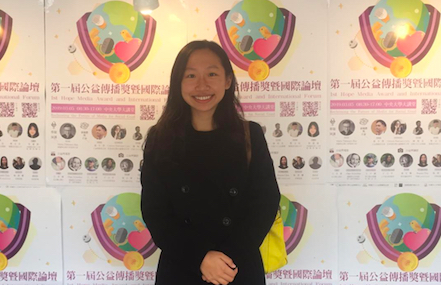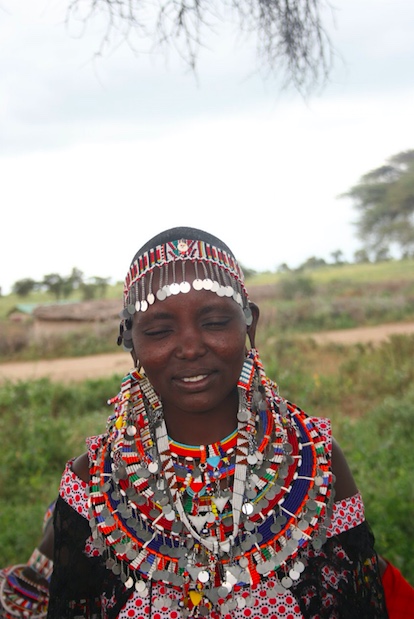Bonnie Chiu is the Managing Director of The Social Investment Consultancy in London, UK. Chiu started her career founding Lensational in her native Hong Kong. The organization puts cameras in the hands of illiterate women to help them express themselves. Subsequently, Forbes named Chiu as one of the ‘30 Under 30 Social Entrepreneurs in Europe’ in 2017. impactmania spoke with Chiu about social entrepreneurship, domestic migrants in Hong Kong, and the impact of a photo camera.
BY PAKSY PLACKIS-CHENG
Do you have an example of how a camera impacted a woman’s life?
In Kenya, we’re working with Maasai women.
They are indigenous people, and because of their patriarchal structures, most Maasai women are illiterate. Because they don’t need to read and write, taking photos becomes a good way to express themselves.
One of the women, Joyce, is only 22 years old. Joyce told us that because of photography, she gained the confidence to use her mobile phone. Before that she felt the phone was too difficult to use, and asked her husband to perform all of the functions for her.
Apart from teaching her how to use the camera, we’ve helped demystify technology. She gained the confidence to reclaim what she deserves.
You supply the camera, correct? How do you train these women?
Yes, we supply the cameras. The cameras are donations from individuals in other parts of the world. We start with eight hours of learning about gender, photography, journalism, and psychology.
We teach about the understanding of self through photography, and there’s advancement of self and society through photography. It’s two sets of focus that they always learn in groups. The group is really important so that they receive support from each other.
How did Joyce in Kenya come across the program?
We always work with local partners. We are in 23 countries. I met a global conservation charity group through an event in London. They just started a program working with Maasai women to train them to become stewards of the environment. There are lots of wildlife roaming around in the area, so there’s a lot of wildlife-human conflict and poaching going around.
If a local partner comes to us, we network to see how they could help us launch this project.
Do you have any idea what Joyce’s husband thinks of his wife having a camera and being trained by a group outside their community?
I think they have evolved their thinking on this. I think they see the value of their wives being a bit more occupied than sitting around. We haven’t really dwelt into that because it’s a difficult conversation. The gender box is a Pandora’s box. It requires really talented and sensitive individuals to have those conversations. So far we see positive feedback, but we haven’t gone into the details, like whether the men feel threatened. As long as the women are happy and have the expressive need, we just carry on.
We interviewed the Research Centre for Migration and Mobility. The foreign domestic workers are one of the groups they are most concerned about with regards to migration issues. Lensational worked with a number of domestic workers in Hong Kong. Do you have any views on what changes are needed for this community?
We try to work directly with the workers so that they know their value and gain in confidence. The cameras provide a way to express themselves that alleviates their stress and benefits their well-being.
We’ve also been trying hard to change the mindset, but that takes so many more players. The employers are mostly Hong Kong Chinese. They need be involved in the conversation. The employers need to see the challenges of their workers and also see them as human beings.
From this basis of empathy and mutual understanding, we believe employers will change their behaviors towards these workers, have more respect, maybe provide better living conditions, and give the workers more rights. We see this starting to happen, but not to the extent required to really facilitate a much more harmonious society.
Thirdly, [which goes] beyond than just Hong Kong, is the need to [understand and] value care work. Care workers are unpaid or underpaid. Domestic work is care work. It is part of the economy.
To really solve the challenges that domestic workers face, including very long working hours, and the lack of personal space, we need a radical rethink of care work and valuing it appropriately. Hong Kong has become one of the best places for migrant domestic workers now.
What kind of measures did Hong Kong take on improving the status of the foreign domestic workers?
My knowledge is only of the past six years. I think the first one is about civil society. A lot of domestic workers self-organized and advocated for change. The workers are allowed to gather in public spaces. In Singapore, groups are not supposed to gather in public spaces without permission.
In Hong Kong, it’s relatively free, and so you have public spaces to gather. That fosters a sense of community and solidarity. Domestic workers in Hong Kong, through self-organizing unions, get support from consulates. That helps them with any advocacy, and for their home governments to take actions necessary to advocate on their behalf—on a government-to-government level.
In 2013, I was exposed to this issue, because I was working at Amnesty International. I was collating newspaper clippings, which were submissions to the Human Rights Press Awards.
There were a lot of clippings related to the sad treatment and the abuse of domestic workers in Hong Kong. There were a few high profile cases where the employers physically assaulted the domestic workers, leading to domestic workers being hospitalized.
The press reporting on these issues also plays a role to ensure that these issues translate into policy changes. In 2018, the minimum wage was increased in Hong Kong for domestic workers and it’s the highest in the region. Domestic workers earn min. 4,520 Hong Kong dollars (575.80 USD). In Singapore, it is half of that.
Give me an example of how multinational companies are involved in supporting the foreign domestic migrants.
Multinationals will sponsor charities in Hong Kong that are working for the advancement of domestic workers. This is an issue that the Hong Kong government does not fund directly, because they don’t consider domestic workers Hong Kong people. In Hong Kong, there’s a complication with citizenship being very tied to ethnicity. Because domestic workers are not seen as Hong Kong people means that government funds can’t get channeled to this group. It requires the public or other organizations to step in to fund.
With the work you have done for Lensational and the Social Investment Consultancy. What have you seen in general that is required to drive cultural, social, and economic impact?
There is a helpful framework that my consultancy has taught me. Creating change can be on three levels. You do direct intervention; you can inform others to deliver or inspire others to deliver; or you really change the system. These three ways need to go hand in hand.
It’s important for anyone, while they’re forming their organization or delivering their own intervention, to also have that broader view and collaborate with others. I guess, of course, you need to start with identifying the issue and being very granular about the issues so you know exactly where you need to interfere.
The reason why Lensational’s intervention has gained traction is that we were really specific. In the beginning, we were looking at women who are illiterate or who can’t express themselves, because of systemic discrimination. We did not just focus on any women.
When we started in March 2013, I did a few pilots, but then I took a year just consolidating the learnings, doing research and planning. Where can we make a difference? We spent that time to think critically about our positioning and ourselves. Not enough people do that.
Give me an example on how you and the Social Investment Consultancy have helped a company incorporate a social dimension into their business practices.
It’s interesting to see it from the perspective of Lensational. As a consultant, often you work with clients, and then someone within the client leaves and that project never gets implemented.
With Lensational you started already with a purpose, right? It is entirely different to incorporate purpose as part of your business practice and mission once you are already established.
No, it’s not about Lensational itself, it’s about how we work with a different company.
In the early days of Lensational, I thought of how we can be self-sustaining. We identified stock photography as an opening for us. I managed to work through people and get into Getty Images, the largest stock photo agency in the world.
I talked to them about the importance of having diversity in stock photography. They were interested in Lensational, but they were treating us like any other contributors. They didn’t see the unique value of Lensational. After a year of not progressing the conversation further, they turned around and invited me to an event to talk about resilience. It was focused on women in leadership. We started working together and gave us a better deal to showcase our culture graphics on their platform and commitment to promote us.
After that, I see them embracing a bit more diversity. Earlier this year, they launched a collection on disability—showing under represented groups in a dignified manner in stock photos.
We help focus on social value in a company by working together with them.
We’ve been working with companies who are facing a changing consumer landscape. A marketing slogan that you care for the world is no longer sufficient. What are your thoughts on how companies can incorporate a social dimension, a more purposeful engagement, into their business practices?
They need to start with the assets and strengths they have. They can also throw money at a problem or they can donate, but businesses have so much to offer in terms of their skills and other assets to create change.
Do you have an example of one of your clients that drives social impact?
I don’t have good case studies from my own work, because these changes are really difficult.
An interesting example is Coca-Cola. I’m not saying they are doing well in general, but this particular example is an interesting one. What assets can they use to create social change? You can buy Coca-Cola in the rural villages in Africa. They have the most amazing supply chain to reach the last mile. If you have a box of Coca-Cola bottles, you have space at the top in the boxes. They gave the capacity to a charity that distributes life saving medicine. The charity no longer needed to spend the money to reach the last mile. [ColaLife ended up sharing the infrastructure, not sharing the actual Coca-Cola crates or boxes].
In the U.S. we’re dealing with an enormous wealth transfer from the older generation to the next generation. A generation will be stewards of trillions of dollars in foundations, donor-advised funds, etc.
Impact investments are still very much associated with lower returns for investors. Do you have any examples of a social enterprise delivering results on par with traditional investments?
There’s that perfect middle where you don’t compromise market returns for social impacts. There’s also that great upper spectrum where actually you have better market returns because of your social impact. But you also have that lower spectrum where you are sacrificing long-term returns for social impact.
To create social impact is incredibly complex. In the upper spectrum, you’re looking at many consumer-facing companies that have products because of their social value that the consumers are actually buying more. There are a few B-corps that operate in this area, whether it’s Ben & Jerry’s or Patagonia. We have a few newer ones like Innocent [smoothie maker] that got bought by Coca-Cola. There’s a tea company called Pukka.
How is Coca-Cola going to deal with a B-Corp in their portfolio? Unilever bought Ben & Jerry’s which caused quite a stir among consumers and investors initially. Ben & Jerry’s is kept pretty separate.
I don’t know. I imagine that would have to be the way. In that area, there’s no trade-off. Actually, social impact has enhanced the market. They are tapping into this kind of conscious consumer trend.
Investors see investments and making a social impact as very separate objectives. If you want to do good, you should write a check and support a nonprofit. If you want to make an investment, it should be an investment to maximize your return. How do we help people get out of that mindset that the two are incompatible?
I think it is hard because investors are coming to this idea of social impact at a later stage of their careers, when they might have a very fixed view of what business ought to be and ought to do.
Perhaps you need to make concessionary loans, or you have to expect lower nets from your market return. But then I’m sure if your investment horizon is long-term enough, you might actually have a better average return. But no one is really looking that far out enough.
In the UK, there’s a fund that’s trying to tackle the social housing market, which has been taken up by a lot of unscrupulous landlords. In that market it’s harder because you have to advocate for policy changes before your product will find that product market fit. I think when there’s market failure, you might have to compromise your market returns, at least in the short-term, for social impact. It’s a more nuanced debate than people make it out to be.
Social Entrepreneurship is not a common track, especially not for people in Asia. How did you get exposed to social entrepreneurship?
I was 16 and part of a Junior Achievement Entrepreneurship Program. It is a nonprofit that trains young people and gives them experience in entrepreneurship. The CEO was a woman, Vivian Lau. She is very short. I remember her telling us about how she challenged herself running marathons.
I thought, wow, this woman is so small, she runs marathons, she talks about running companies, and she thinks entrepreneurship is really key. The organization gave out CSR [Corporate Social Responsibility] awards for companies.
In the annual reports, you had to write a section about how you gave back to society. I didn’t really think much of it at that time—that social entrepreneurship was not possible or that it’s so much harder for women to be a CEO.
Seeing people like Vivian made a difference. I also went to the University of North Carolina at Chapel Hill (UNC) for a semester. That was a great experience, because I met so many social entrepreneurs. I met the founder of Global Giving and a social entrepreneur that empowered women in Africa. They encouraged me to pursue social entrepreneurship. Also to the credit of my university in Hong Kong, they did a lot of social enterprise competitions.
I have really enjoyed this career path. I hope my story also helps other people, especially women who might be withheld from doing what they really want.



